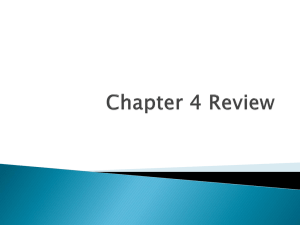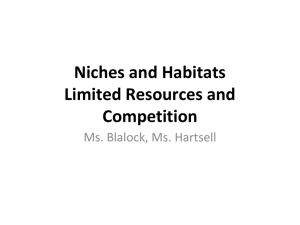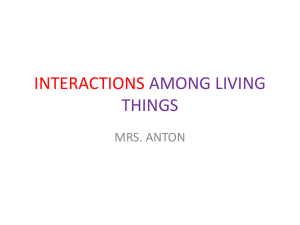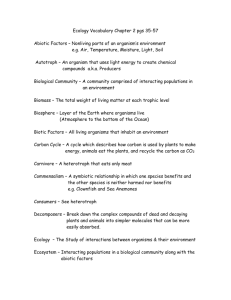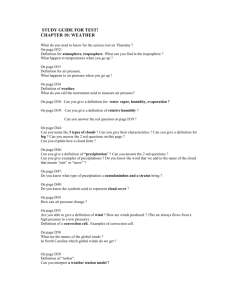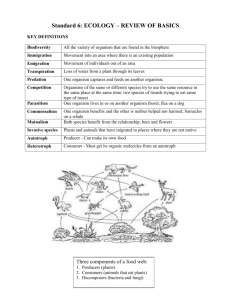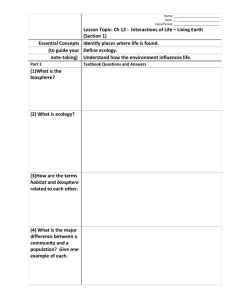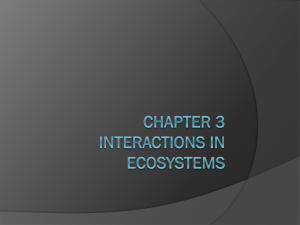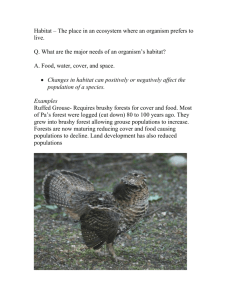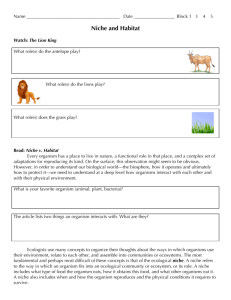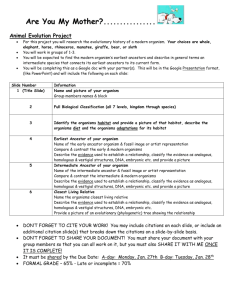ECOLOGY - Boyle County Schools
advertisement
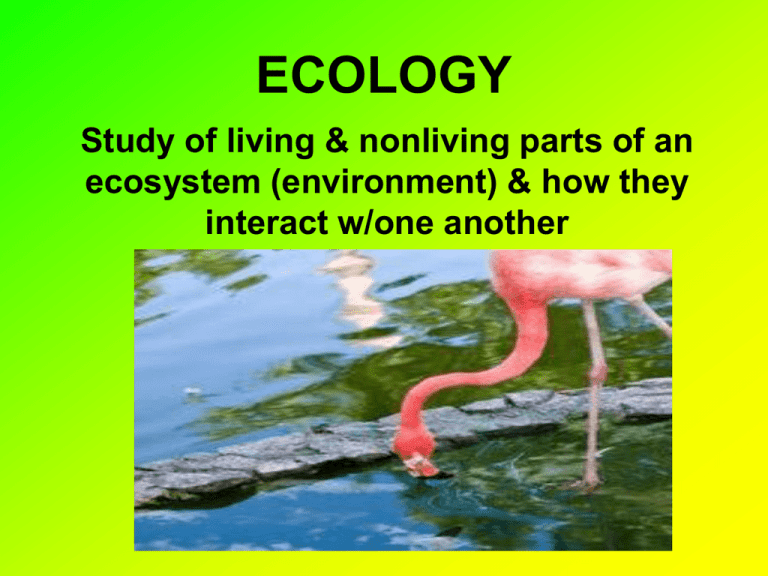
ECOLOGY Study of living & nonliving parts of an ecosystem (environment) & how they interact w/one another I. 2 parts of Ecology A. Abiotic – nonliving; ex. Sun, water, temp., land, soil, air, humidity B. Biotic – living; plants (producers), animals (consumers – herbivores (plant-eaters), omnivores (both), & carnivores (meat-eaters) and decomposers (bacteria, fungi) II. Biome – large area w/ characteristic plants, animals & conditions A. Tropical Rainforest – warm, lots of rain, plants/vines, insects, animals B. Coniferous Forest – cool temps., conifers, (evergreens), deer, elk C. Deciduous Forest – seasons, deciduous trees (lose leaves in fall), deer, raccoons; Kentucky Deciduous & Rain Forest – 3:35 Coniferous Forest – 1:20 D. Grassland – seasons, grasses, prairie dogs, bison Grasslands – 1:58 E. Tundra – cold, permafrost (permanently frozen soil), lichens, mosses, polar bears Tundra – 1:06 F. Desert – DRY, many are hot during day & cold at night, cacti, reptiles, nocturnal animals Deserts – 1:51 G. Aquatic – marine (saltwater) & freshwater Marine Biomes – 2:24 III. Habitat – physical area in which an organism lives (smaller) A. Niche – way of life of a species; ex. Habitat, feeding habits, other habits, reproductive behavior What is the wolf’s niche? Habitat/Niche – 2:18 B. Population – many organisms of the same species in an area; ex. all people, rabbits, trees, etc. C. Community – many populations in an area; ex. all the deer, rabbits, trees, etc. Populations & Communities – 2:19 D. Food chains – shows energy in a habitat; what eats what; ex. grass grasshopper frog snake hawk E. Food Pyramid – takes organisms from a food chain & puts them in a pyramid ex. Quaternary cons. Tertiary cons. Secondary cons. Primary consumer Producer 90% energy lost at each level due to: Movement Digestion Respiration Excretion Reproduction Growth Energy 10 lost 90 100 900 1000 9000 10,000 90,000 100,000 Food Pyramid shows: • What eats what • Need more organisms at bottom to support things above it • More energy at bottom/less at top • Lose energy (90%) at each level Energy Pyramids – 1:05 F. Food Web – many food chains linked together; shows interactions of all organisms in a community Food Web Food Chains & Food Webs – 1:53 G. Competition – use or defense of a resource by one individual that reduces the availability of the resource to other individuals; ex. Organisms compete for food, space oxygen shelter, etc. (called limiting factors) These two species are in direct competition for food. H. Relationships 1. predator – organism that feeds upon another 2. prey – organism that is eaten 3. parasitism – one organism benefits while the other is harmed; ex. leeches 4. commensalism – one organism benefits & the other is unaffected; ex. clown fish live in anemones (remember Finding Nemo) because other fish avoid the stinging tentacles 5. Mutualism – both benefit; ex. flowers and bees I. Carrying Capacity – the maximum # of organisms an area can hold J. Community Changes: succession – series of changes that take place in a community as it ages 1.Land: grasses shrubs trees (climax community) 2. Water: lakes ponds bogs/ swamps land K. Biochemical Cycles 1. Water cycle: evaporation, transpiration, precipitation, condensation Water Cycle – 1:02 2. Oxygen/ Carbon cycle: cell respiration/ photosynthesis Oxygen - Carbon Cycle – 1:27 3. Nitrogen cycle: Nitrogen “fixed” to usable form (nitrogen fixation) to form proteins Nitrogen Cycle – 1:37
